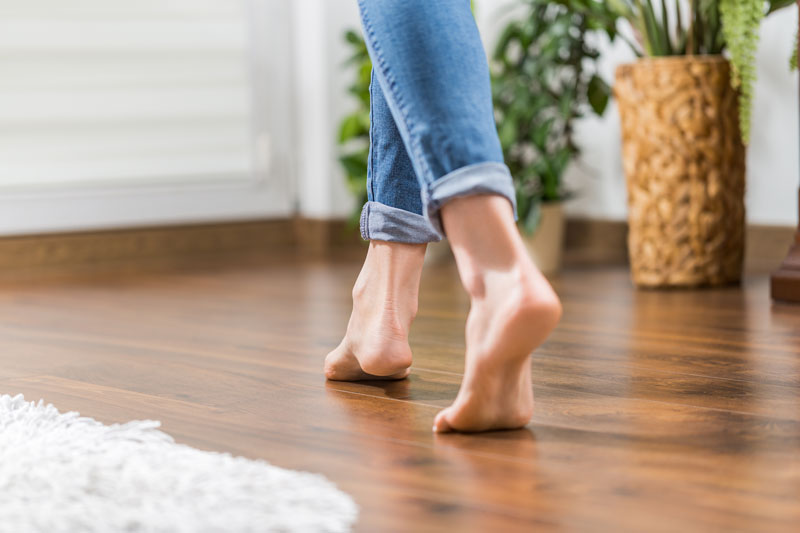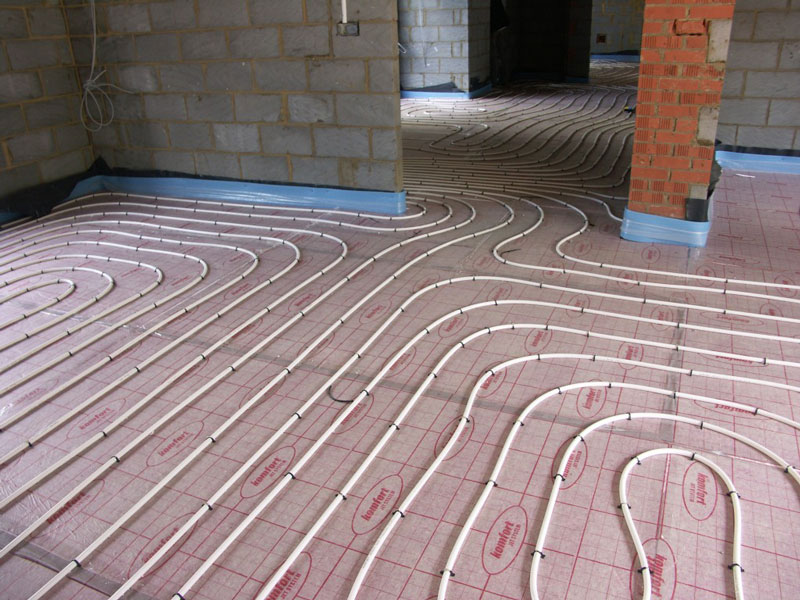Underfloor heating for new build properties

The best and most cost-effective time to incorporate wet underfloor heating into a project is at the new build stage. Not only is UFH a more efficient heating method, but also more desirable for homeowners, making the properties more valuable for the developer. Screeded systems are undoubtedly the most popular choice for new-build properties, and here at Ambiente we have all the helpful resources to ensure your wet ufh installation is quick, simple and hassle-free.
Why it’s best to incorporate UFH at the new-build stage
Incorporating underfloor heating at the new-build stage is a far simpler process than in a refurbishment project, which would most likely require a bespoke retro-fit solution. At the new build stage, you have much more scope to include UFH as you are working within the complete floor structure, rather than from a finished concrete surface as in a retrofit scenario.
UFH solutions for new-build properties ultimately have better heat outputs and are more efficient, leading to more effective heating and a lower fuel bill. This is not only due to the system type, but also the quantity of insulation that is installed in a new-build property.
It is also easier to install the necessary wiring for UFH in a new-build property, rather than chasing wires into existing walls and floors. There is also the option of incorporating wireless thermostats. This ultimately results in a more straightforward, and therefore cheaper, installation.
What are the benefits of underfloor heating?
+ FLEXIBILITY – Underfloor heating is typically zoned into different areas, giving the user complete control over the temperature of their property. Different rooms can be set to different temperatures and programmed around the lifestyle of the user, resulting in a completely flexible heating solution.
+ EFFICIENCY – Underfloor heating produces a far more efficient pattern than that of traditional convectional heating systems like radiators, which often result in the warmest part of the room being at ceiling height. UFH works by heating via radiation from the ground upwards, so the room heats comfortably and evenly.
+ DESIGN FREEDOM – Underfloor heating pipework is concealed within the floor construction so there’s nothing to limit the interior design. Without the need for bulky and sometimes hazardous radiators taking up wall and floor space, the designer will have a completely flexible room layout to play with.
How does new build wet underfloor heating increase the value of a home?
Underfloor heating is regarded as a luxury and is definitely worth the extra cost, especially if you’re starting a project from scratch. It will boost the value of a property because of the appeal of lower energy bills for the purchaser, as well as it being perceived as the luxury heating method.
Not only does it allow for design freedom as detailed above, it also boasts the advantages of silent operation and the elimination of draughts or cold spots. Some systems can even be switched to cooling mode for the summer months, in which cool water is circulated around the pipework instead. The ongoing expenses are also a big draw, being lower than conventional heating systems due to higher efficiency and fewer maintenance requirements. These sought-after upmarket features can elevate a property and increase saleability.
Just to add to the luxurious image of underfloor heating – it can be entirely controlled via a simple and stylish thermostat control. Here at Ambiente, we make installing underfloor heating thermostats simple, leaving the user with the ability to preselect the time they want the heating to be operating and the temperature it should reach during those periods. There are even upgrade options that enable the user to control the system from their smartphone or tablet.
What floor coverings can be used with wet underfloor heating?
The majority of floor finishes can be used in conjunction with wet underfloor heating. However, it’s best if this is considered early on in the design stage to ensure the resistance value of the chosen floor covering does not adversely affect the output of the system. All floor coverings have a ‘tog’ rating, which is a measure of resistance. The tog rating should ideally not exceed 2.5 tog (including any underlays) when installed over underfloor heating. Whether it’s stone, carpets, or laminate, when it comes to choosing which floor coverings with UFH you have a range of options available.
Is wet underfloor heating only for new build modern homes or can it be installed in older properties?
Whilst it is both easier and cheaper to install wet underfloor heating in new builds, there are a number of systems suitable for the refurbishment of older properties. At Ambiente, we supply a range of low profile systems, which are ideal for retrofit scenarios where floor build-up height is at a premium. Our suspended floor systems are also well suited to existing floor structures, with their unique ‘fit-from-beneath’ feature.
On some occasions, it’s not possible to incorporate an existing system and so a bespoke UFH (link to new blog) solution is required. Ambiente’s bespoke service caters for any unusual or demanding requirements and our team works with you to design the best system to meet the needs of the property.
How easy is it to correctly install wet underfloor heating in a new build?
At Ambiente, we make installation as simple as possible. Our installer customers have access to many helpful resources to assist them in carrying out a safe and successful install, including specific installation guides, demonstration videos, CAD drawings and wiring diagrams. We also supply bespoke pipe layout designs tailored to the parameters of each individual project.
Ensuring that this guidance is provided prior to install means that the job can go smoothly and specified timescales are met. There is even the option of having UFH installer training on site if required, and if any problems are encountered during install our support team are ready to answer your questions and ensure a neat and swift installation.
How much does new build wet underfloor heating cost – how does it affect energy bills?
The initial upfront cost of wet underfloor heating is slightly higher than that of traditional heating solutions, however, the ongoing running costs are lower and is therefore more cost effective in the long run.
These lower running costs are because underfloor heating is a more efficient solution than radiators, requiring less energy to create the optimal room temperature. UFH is around 25% more efficient when paired with a modern condensing boiler and up to 40% more efficient when running from a heat pump. Inefficient radiators often lead to overheating, which in turn leads to windows being opened and even more energy being wasted.
Installing wet UFH is a very cost-effective solution, especially in new builds. The simpler installation process is much quicker, and reduced install times means less money is spent on site. The ability to choose an existing system without bespoke features also keeps costs down and gets a project completed sooner.
What is the best wet underfloor heating system for new builds?
Screeded UFH systems are the most popular and most effective form of wet underfloor heating. The pipework is clipped to the top of the insulation layer prior to screeding, resulting in an even heat distribution across the entire screed slab. These systems are ideally suited to new build projects as they’re flexible and quick to install, and easily adapted to the available space. As the entire screed slab is heated, the heating process is gentle and even, creating a comfortable living environment with no draughts or cold spots. The winning combination of exceptional performance and straightforward install within a newly designed floor construction continues to make screeded systems the best choice for new builds.
Do you have a new build project coming up?
Get in touch with our team today to discuss your underfloor heating requirements. Simply call us on 01707 649 118 or email info@ambienteufh.co.uk
Did you find this article useful? Check out our installers guide to underfloor heating thermostat controls and our installers guide to underfloor heating manifolds.
This article was written by Robert Tuffin.
Robert is the General Manager at Ambiente and has been working in the underfloor heating industry since 2012.




